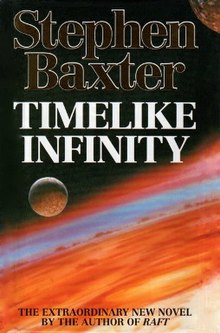Timelike Infinity

First edition
|
|
| Author | Stephen Baxter |
|---|---|
| Cover artist | Chris Moore |
| Country | United Kingdom |
| Language | English |
| Series | Xeelee Sequence |
| Genre | Science fiction |
| Publisher | HarperCollins (UK) |
|
Publication date
|
7 December 1992 |
| Media type | |
| Pages | 253 |
| ISBN | |
| OCLC | 27959074 |
| Preceded by | Raft |
| Followed by | Flux |
Timelike Infinity is a 1992 science fiction book by Stephen Baxter. The second book in the Xeelee Sequence, Timelike Infinity introduces a universe of powerful alien species and technologies which manages to maintain a realistic edge due to Baxter's physics background; it largely sets the stage for the magnum opus of the Xeelee Sequence, Ring (as opposed to Vacuum Diagrams, Flux, or Raft, which concern themselves with side-stories).
Set thousands of years in the future (AD 5407), the human race has been conquered by the Qax, a truly alien turbulent-liquid form of life, who now rule over the few star systems of human space – adopting processes from human history to effectively oppress the resentful race. Humans have encountered a few other races, including the astoundingly advanced Xeelee, and been conquered once before – by the Squeem – but successfully recovered.
A human-built device, the Interface project, returns to the solar system after 1,500 years. The project, towed by the spaceship Cauchy, returns a wormhole gate, appearing to offer time travel due to the time 'difference' between the exits of the wormhole (relativistic time dilation), with one end having remained in the solar system and the other travelling at near lightspeed for a century. The Qax had destroyed the solar system gate, but a lashed-up human ship (a great chunk of soil including Stonehenge, crewed by a group called the Friends of Wigner) passes through the returning gate, travelling back to the unconquered humanity of 1,500 years ago.
One of the crew of the Cauchy returns with the Friends, Miriam Berg. The Friends have a complex scheme, which does not include a simple military return-and-rescue – the 1,500-year technology gap makes this "risible". From the Wigner thought experiment they have postulated an unusual theory on the ultimate destiny of life in the universe. They believe that quantum wave-functions do not collapse like the Copenhagen interpretation holds, nor that each collapse actually buds off separate universes (like the quantum multiverse hypothesis holds) but rather that the universe is a participatory universe: the entire universe exists as a single massive quantum superposition, and that at the end of time (in the open universe of the Xeelee Sequence, time and space are unbounded, or more precisely, bounded only at the Cauchy boundaries of "Time-like infinity" and "Space-like infinity"), when intelligent life has collected all information (compare the Final anthropic principle and the Omega Point), and transformed into an "Ultimate Observer", who will make the "Final observation", the observation which collapses all the possible entangled wave-functions generated since the beginning of the universe. They believe further that the Ultimate Observer will not merely observe, but choose which world line will be the true world-line, and that it will choose the one in which humanity suffers no Squeem or Qax occupations. However, the Ultimate Observer cannot choose between worldlines if no information survives to its era to distinguish worldlines- if the UO never knows of humanity, it cannot choose a worldline favourable to it. In other words, some way is needed to securely send information forward in time.
...
Wikipedia
